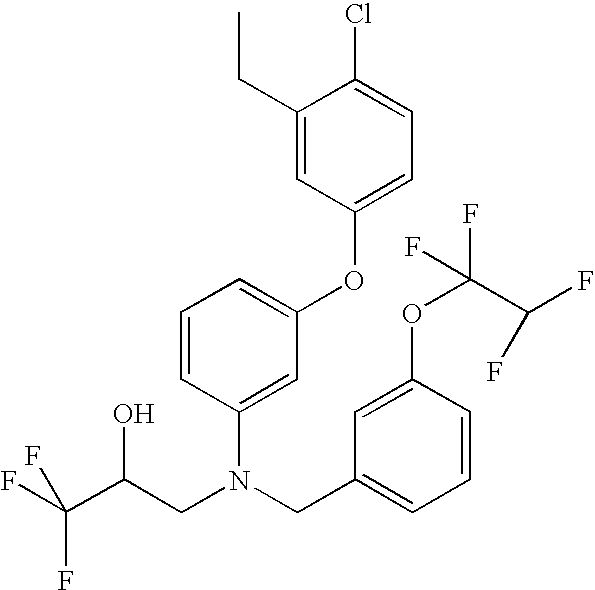Nanoparticles comprising a cholesteryl ester transfer protein inhibitor and anon-ionizable polymer
a technology of cholesteryl ester transfer protein and nanoparticles, which is applied in the field of nanoparticles, can solve the problems of reducing compliance, no wholly satisfactory hdl-elevating therapy exists, and negatively correlated hdl-cholesterol levels with the risk of cardiovascular diseases, so as to improve the bioavailability of cetpi
- Summary
- Abstract
- Description
- Claims
- Application Information
AI Technical Summary
Problems solved by technology
Method used
Image
Examples
example 1
[0101]Nanoparticles containing Drug 1 were made using the following procedure. First, 300 mg Drug 1 and 300 mg ethylcellulose were dissolved in 7.5 mL ethyl acetate. The organic solution was then poured into 30 mL of water and the mixture was emulsified for 3 min using a Kinematica Polytron 3100 rotor / stator (Kinematica AG, Lucerne, Switzerland) at 10,000 rpm (high-shear mixing). The solution was further emulsified using a Microfluidizer (Microfluidics [Newton, Mass.] model M-110S F12Y with ice bath and cooling coil), for 6 minutes (high-pressure homogenization). The ethyl acetate was removed from the emulsion using a rotary evaporator, resulting in an aqueous suspension of nanoparticles consisting of 50 wt % Drug 1 and 50 wt % ethylcellulose.
Light Scattering Analysis
[0102]The particle size of the nanoparticles in the aqueous suspension was determined using dynamic light scattering (DLS) as follows. First, the aqueous suspension was filtered using a 1 μm glass membrane filter (Anato...
example 2
[0103]For Example 2, nanoparticles containing Drug 1 were prepared using the procedures described in Example 1 with the following exceptions. The organic solution contained 300 mg Drug 1 and 300 mg pCL-PEG in 7.5 mL ethyl acetate. This organic solution was mixed with 30 mL deionized water and emulsified using the procedures outlined in Example 1 to form nanoparticles having a cumulant diameter of 117 nm and a polydispersity of 0.19.
example 3
[0104]Nanoparticles containing Drug 2 were prepared as follows. First, 120 mg Drug 2 and 420 mg ethylcellulose were dissolved in 7.5 mL methylene chloride to form an organic solution. Next, 60 mg sodium taurocholate (NaTC, a surface stabilizer) was added to 30 mL deionized water to form an aqueous solution. The organic solution was then poured into the aqueous solution and emulsified as described in Example 1. The methylene chloride was removed from the emulsion using a rotary evaporator, resulting in an aqueous suspension of nanoparticles, with a composition ratio of 20:70:10 Drug 2:ethylcellulose:NaTC. DLS analysis showed that the average cumulant diameter of the nanoparticle suspension was 64 nm, with a polydispersity of 0.20.
PUM
| Property | Measurement | Unit |
|---|---|---|
| size | aaaaa | aaaaa |
| solubility | aaaaa | aaaaa |
| wt % | aaaaa | aaaaa |
Abstract
Description
Claims
Application Information
 Login to View More
Login to View More - R&D
- Intellectual Property
- Life Sciences
- Materials
- Tech Scout
- Unparalleled Data Quality
- Higher Quality Content
- 60% Fewer Hallucinations
Browse by: Latest US Patents, China's latest patents, Technical Efficacy Thesaurus, Application Domain, Technology Topic, Popular Technical Reports.
© 2025 PatSnap. All rights reserved.Legal|Privacy policy|Modern Slavery Act Transparency Statement|Sitemap|About US| Contact US: help@patsnap.com



